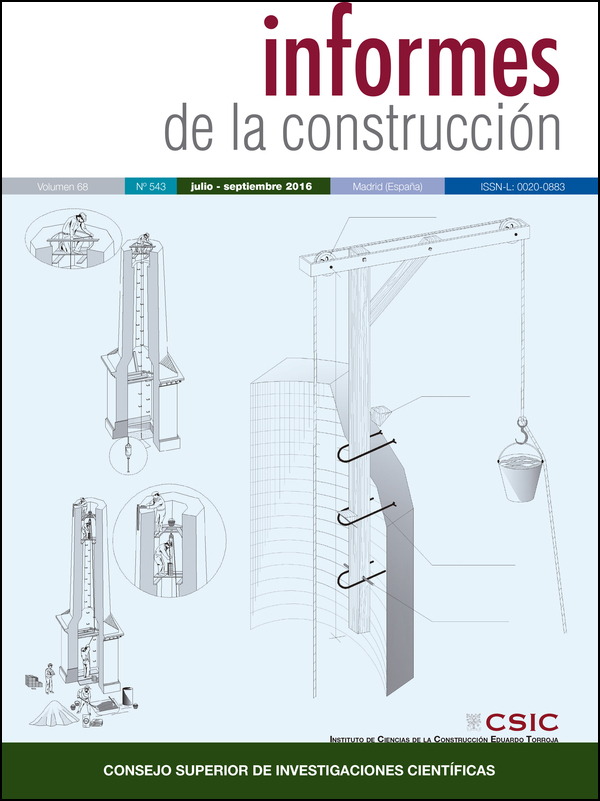Study of slab on grade thickness for racking throughout Finite Element Method
DOI:
https://doi.org/10.3989/ic.15.093Keywords:
Racking post loading, slab on grade thickness, FEMAbstract
In the current paper, comparative analyses between three procedures of calculation have been developed, in order to obtain slab on grade thicknesses when the slabs are loaded with racking posts. For this case, the classical expression of Westergaard cannot be applied directly because of the influence of the remainder posts and their proximity. Firstly, the comparative analysis has been done by means of bibliographical design abacus; in the second place, the slab is discretized with finite elements resting above the soil modelled with soil reaction springs; and in third place, a three dimensional solid finite element model represents the base and subgrade set. In the paper some innovative issues regarding the thickness performance and the grade slab interaction are developed. Finally, a series of graphical results are obtained allowing for the pre-design.
Downloads
References
(1) Mecalux, S. A. (2011). Manual técnico del almacenaje. Mecalux, p. 155. Mecalux, S. A.
(2) Ferrer, C., Ferrán, J.J., Ferrer, C.M. (2000). Contribución al estudio, cálculo y dise-o de soleras de hormigón en masapara la actividad agroindustrial. Informes de la Construcción, 51(466): 23. CSIC, http://informesdelaconstruccion.revistas.csic.es/index.php/informesdelaconstruccion/article/view/712/797.
(3) Westergaard, H.M. (1926). Stresses in Concrete Pavements Computed by Theoretical Analysis. Public Roads, 7(2): 25.
(4) Pickett, G., Ray, G.K. (1951). Influence Charts for Concrete Pavements. Trans. ASCE, 116: 49.
(5) Meyerhof, G.G. (1962). Load carrying capacity of concrete pavements. Journal of the Soil Mechanics and Foundations Division, Proceedings of the American Society of Civil Engineers.
(6) Shentu, L., Jiang, D., Hsu, C.T. (1997). Load-carrying capacity for concrete slabs on grade. Journal of Structural Engineering, 123: 95-103. http://dx.doi.org/10.1061/(ASCE)0733-9445(1997)123:1(95)
(7) Azzi, V.D., Laird, R.H. (2008). Load-Carrying Capacity Concrete Slabs-On-Grade Subject to Concentrated Loads. Structure Magazine, April: 18-21.
(8) Technical Report No. 34 (2014) Concrete Industrial Ground Floors - A guide to their Design and Construction, p. 30. Concrete Society. Fourth Edition.
(9) Technical Report No. 34 (1994). Concrete Industrial Ground Floors - A guide to their Design and Construction, p. 69. Concrete Society. Second Edition.
(10) ACI 360R-92 (Reapproved 1997). Design of Slabs on Grade, p. 43 p.12. American Concrete Institute.
(11) ACI 360R-10 (2013). Guide to Design of Slabs-on- Ground, p. 59 p.12. American Concrete Institute.
(12) Fwa, T.F. (2006). The Handbook of Highway Engineering, p. 9-53. Taylor & Francis.
(13) Ministerio de Fomento. (2008). EHE-08. Instrucción de Hormigón Estructural, p. 167.
(14) Ferrer Gisbert, C. (1998). Contribución al estudio de soleras de hormigón de industrias agroalimentarias mediante la técnica de los elementos finitos. Tesis Doctoral. Universidad Politécnica de Valencia, pp. 164-166.
(15) Rodríguez Ortiz, J.M., Serra Gesta, J., Oteo Mazo, C. (1986). Curso aplicado de cimentaciones, tercera edición, pp. 32-34, 162. COAM.
(16) Look, B. (2007). Handbook of Geotechnical Investigation and Design Tables, p. 127. Taylor & Francis. http://dx.doi.org/10.1201/9780203946602
(17) Ministerio de Vivienda. (2006). CTE-DB-SE-C. Cimientos, p. 123.
(18) PG3. (2007). Pliego de prescripciones técnicas generales para obras de carreteras y puentes, pp. 229-238. Liteam Ediciones.
(19) Ministerio de Fomento. (2003). Orden FOM/3460/2003, 6.1-IC secciones de firme. Instrucción de carreteras. Boletín Oficial del Estado, n.º 297.
(20) Winterkorn, H.F., Fang H. (1975). Foundation Engineering Handbook, p. 519. Van Nostrand Reinhold Company.
(21) PCA. (1966). Thickness Design for concrete Pavements. Portland Cement Association.
(22) Papworth, F., Royce, R., Norton, P. Design of steel fibre reinforced concrete slabs on ground and shotcrete linings. Norton Construction Products.
(23) Escario, J.L., Escario, V., Balaguer, E. (1973). Caminos (Tomo II) Firmes de carreteras y aeropuertos, p. 982. ETSI, Caminos, Canales y Puertos, Universidad Politécnica de Madrid.
(24) Everseries© User's Guide. (2005). Pavement Analysis Computer Software and Case Studies. Washington State Department of Transportation.
(25) Australia T34. (1985). Concrete Industrial Floor and Pavement Design. Cement and Concrete Association of Australia.
(26) Jofré, C., Vaquero, J.J. (2000). Manual de pavimentos industriales, pp. 60-63. IECA.
(27) Wilson, E.L. (1999). Three Dimensional Static and Dynamic Analysis of Structures. Berkeley, California (USA): Computers & Structures, Inc.
(28) Ferrer, C.M., Vallés, J.J. (1992). Apuntes de Construcción II. Universidad Politécnica de Valencia.
(29) Mc Carthy D.F. (1993). Essentials of Soil Mechanics and Foundations: Basic Geotechnics, p. 228. Prentice Hall & Technology.
Published
How to Cite
Issue
Section
License
Copyright (c) 2016 Consejo Superior de Investigaciones Científicas (CSIC)

This work is licensed under a Creative Commons Attribution 4.0 International License.
© CSIC. Manuscripts published in both the print and online versions of this journal are the property of the Consejo Superior de Investigaciones Científicas, and quoting this source is a requirement for any partial or full reproduction.
All contents of this electronic edition, except where otherwise noted, are distributed under a Creative Commons Attribution 4.0 International (CC BY 4.0) licence. You may read the basic information and the legal text of the licence. The indication of the CC BY 4.0 licence must be expressly stated in this way when necessary.
Self-archiving in repositories, personal webpages or similar, of any version other than the final version of the work produced by the publisher, is not allowed.















